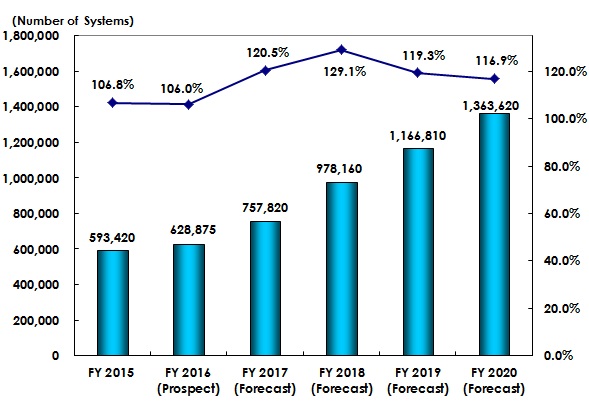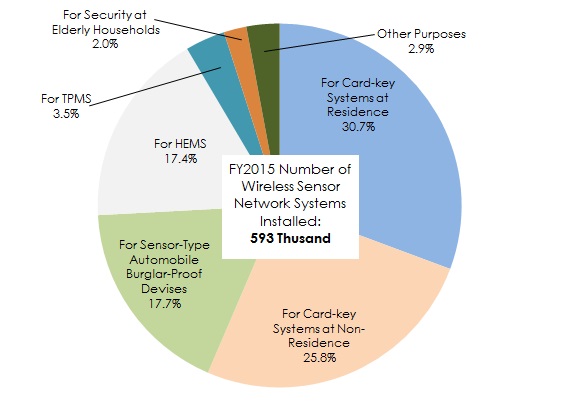Forecast Number of Wireless Sensor Network Systems in Japan: Key Research Findings 2016
Research Outline
- Research period: September 2015 to June 2016
- Research target: IT businesses/Siers, common carriers, device manufacturers, public research institutes
- Research methodologies: Face-to-face interviews by expert researchers, surveys via telephone/email, and literature research
<What is wireless sensor network (WSN)?>
The sensor network in this research indicates a network system consisted of multiple sensor nodes spaciously distributed, each of which connected wirelessly or with wire to a central node where a gateway is. The data from multiple sensor nodes are collected and sent directly or through gateway to servers, PCs, and etc. The sensor nodes are usually consisted of one or more sensors, CPUs, communication devices, power sources (including AC power sources, or batteries), embedded software and etc. Note that this research targets those WSN systems consisted of only sensors and data loggers, so that any of the following devices are not included: Devices that are used standalone; smart devices including smartphones; and RFID (Radio Frequency Identification) systems.
Note also that this research targets the following nine categories where WSN systems are used: 1) Energy management, 2) Infrastructure/streets, 3) Factories/manufacturing, 4) Security, 5) Agriculture/farming, 6) Healthcare, 7) Logistics/distribution, 8) Nature/environment monitoring, 9) automobiles.
Summary of Research Findings
- Domestic Wireless Sensor Network Systems in FY2015 Rose to 593 Thousand Systems, Expected to Reach 1,364 Thousand by FY2020
The domestic wireless sensor network system market in FY2015 grew steadily by 6.8% from the previous fiscal year to attain 593 thousand systems, based on the number of systems installed at end users. Those systems used for energy management, such as HEMS, and for card-key systems have grown favorably, as well as those sensor-types used for automobile burglar-proof devises. Usage of the domestic wireless sensor network systems is likely to expand to the area of watch services at elderly long-term care facilities or for home nursery care during FY2017 and FY2018. The domestic number of sensor network systems installed at end users is expected to rise to 1,364 thousand by FY2020.
- 56.5% of Domestic Wireless Sensor Network Systems Installed for Card-Key Systems, and 17.7% for Sensor-Type Automobile Burglar-Proof Devises in FY2015
When looking at the component ratio of FY2015 domestic wireless sensor network systems installed at end users by use, card-key systems for residence and non-residence dominated at 56.5%, followed by sensor-type automobile burglar-proof devices to account for 17.7%, and HEMS to hold 17.4%, total of which occupies 91.6%. This means that the wireless sensor network is currently limitedly used, because the market is still at the dawn, yet to expand further.
- Figure 1 :Forecast of Domestic Wireless Sensor Network System Market

- Figure 2: Component Ratio of FY2015 Domestic Number of Wireless Sensor Network Systems Installed by Use
